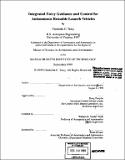Integrated entry guidance and control for autonomous reusable launch vehicles
Author(s)
Tracy, Chisholm C. (Chisholm Cain), 1975-
DownloadFull printable version (9.188Mb)
Other Contributors
Massachusetts Institute of Technology. Dept. of Aeronautics and Astronautics.
Advisor
Wallace E. Vander Velde.
Terms of use
Metadata
Show full item recordAbstract
The guidance and control approach employed on current reusable launch vehicles is based on classical control techniques developed for the Space Shuttle more than 20 years ago. This approach partitions the guidance and control tasks into separate loops resulting in a complex control architecture that can be difficult to adapt to new vehicle designs. A new entry guidance and control technique based on time-invariant linear quadratic regulator theory is presented. This approach integrates the guidance and control functions into a single multivatiable control loop that theoretically should yield improved performance over classical designs and greatly simplify the control architecture. This research is part of a larger effort to develop a next generation guidance and control system that can be implemented onboard the vehicle to increase robustness to unexpected flight conditions and abort scenarios. The integrated guidance and control algorithm is implemented in a nonlinear simulation of the Orbital Sciences X-34, a testbed for reusable launch vehicle technology. The performance and robustness of the linear quadratic regulator algorithm is compared to the classical guidance and control system developed by Orbital Sciences. The results indicate that the overall performance and robustness potential of the integrated guidance and control technique is similar to that of the classical approach. The integration of guidance, control, lateral, and longitudinal dynamics is not observed to yield significant performance improvements under the conditions tested. However, the integrated approach provides an equally effective, simplified control architecture that could allow onboard calculation of control gains in the future to yield a more robust system.
Description
Thesis (S.M.)--Massachusetts Institute of Technology, Dept. of Aeronautics and Astronautics, 1999. Includes bibliographical references (p. 163-164).
Date issued
1999Department
Massachusetts Institute of Technology. Department of Aeronautics and AstronauticsPublisher
Massachusetts Institute of Technology
Keywords
Aeronautics and Astronautics.